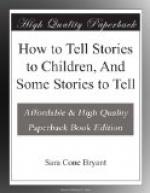“Pooh, child,” said the old Frog, “that was only Farmer White’s Ox. He is not so very big. I could easily make myself as big as he.” And he blew, and he blew, and he blew, and swelled himself out.
“Was he as big as that?” he asked the little Frog.
“Oh, much bigger,” said the little Frog.
The old Frog blew, and blew, and blew again, and swelled himself out, more than ever.
“Was he bigger than that?” he said.
“Much, much bigger,” said the little Frog.
“I can make myself as big,” said the old Frog. And once more he blew, and blew, and blew, and swelled himself out,—and he burst!
Self-conceit leads to self-destruction.
THE FIRE-BRINGER[1]
[Footnote 1: Adapted from The Basket Woman, by Mary Austin.]
This is the Indian story of how fire was brought to the tribes. It was long, long ago, when men and beasts talked together with understanding, and the grey Coyote was friend and counsellor of man.
There was a Boy of the tribe who was swift of foot and keen of eye, and he and the Coyote ranged the wood together. They saw the men catching fish in the creeks with their hands, and the women digging roots with sharp stones. This was in summer. But when winter came on, they saw the people running naked in the snow, or huddled in caves of the rocks, and most miserable. The Boy noticed this, and was very unhappy for the misery of his people.
“I do not feel it,” said the Coyote.
“You have a coat of good fur,” said the Boy, “and my people have not.”
“Come to the hunt,” said the Coyote.
“I will hunt no more, till I have found a way to help my people against the cold,” said the Boy. “Help me, O Counsellor!”
Then the Coyote ran away, and came back after a long time; he said he had found a way, but it was a hard way.
“No way is too hard,” said the Boy. So the Coyote told him that they must go to the Burning Mountain and bring fire to the people.
“What is fire?” said the Boy. And the Coyote told him that fire was red like a flower, yet not a flower; swift to run in the grass and to destroy, like a beast, yet no beast; fierce and hurtful, yet a good servant to keep one warm, if kept among stones and fed with small sticks.
“We will get this fire,” said the Boy.
First the Boy had to persuade the people to give him one hundred swift runners. Then he and they and the Coyote started at a good pace for the far away Burning Mountain. At the end of the first day’s trail they left the weakest of the runners, to wait; at the end of the second, the next stronger; at the end of the third, the next; and so for each of the hundred days of the journey; and the Boy was the strongest runner, and went to the last trail with the Counsellor. High mountains they crossed, and great plains, and giant woods, and at last they came to the Big Water, quaking along the sand at the foot of the Burning Mountain.




